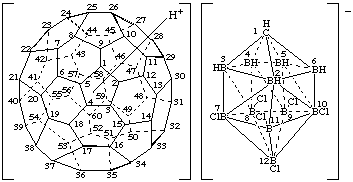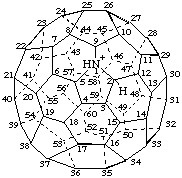
(C60-Ih) [5,6]Fullerenium 7,8,9,10,11,12-hexachloro-1-carbadodecaborate(1-)

2H-1-Aza(C60-Ih)[5,6]fulleren-1-ium
or
1,2-Dihydro-1-azonia(C60-Ih)[5,6]fullerene
Spiro[1(9)a-homo(C60-Ih)[5,6]fullerene-1a,4'-piperidin]-1'-ium
Contents of this section
Examples:

(C60-Ih) [5,6]Fullerenium 7,8,9,10,11,12-hexachloro-1-carbadodecaborate(1-)

2H-1-Aza(C60-Ih)[5,6]fulleren-1-ium
or
1,2-Dihydro-1-azonia(C60-Ih)[5,6]fullerene
Spiro[1(9)a-homo(C60-Ih)[5,6]fullerene-1a,4'-piperidin]-1'-ium
Note. The suffixes '-elide' and '-elium' are approved by IUPAC but no other publication has yet appeared in which they have been used. They were created to take the place of the two part suffixes '-uidyl' and '-iumyl' for radical ions located in the same parent structure.Examples:
[C60]•+ (C60-Ih)[5,6]Fullerenelium
Examples:
| iLa[C60-Ih] | (C60-Ih)[5,6]Fullerene-incar-lanthanum |
| Lanthanum-incar-(C60-Ih)[5,6]fullerene |
Note: The CA index name for the first example is [5,6]fullerene-C60-Ih compd. with lanthanum (1:2).When the metal is located outside the fullerene cage, the compound is named as a salt of the fullerene. The fullerene component name is fulleride, and it is followed by the appropriate negative charge in parentheses.
Example: